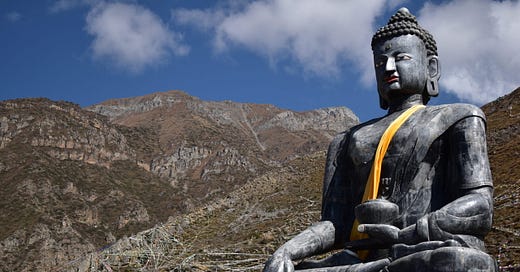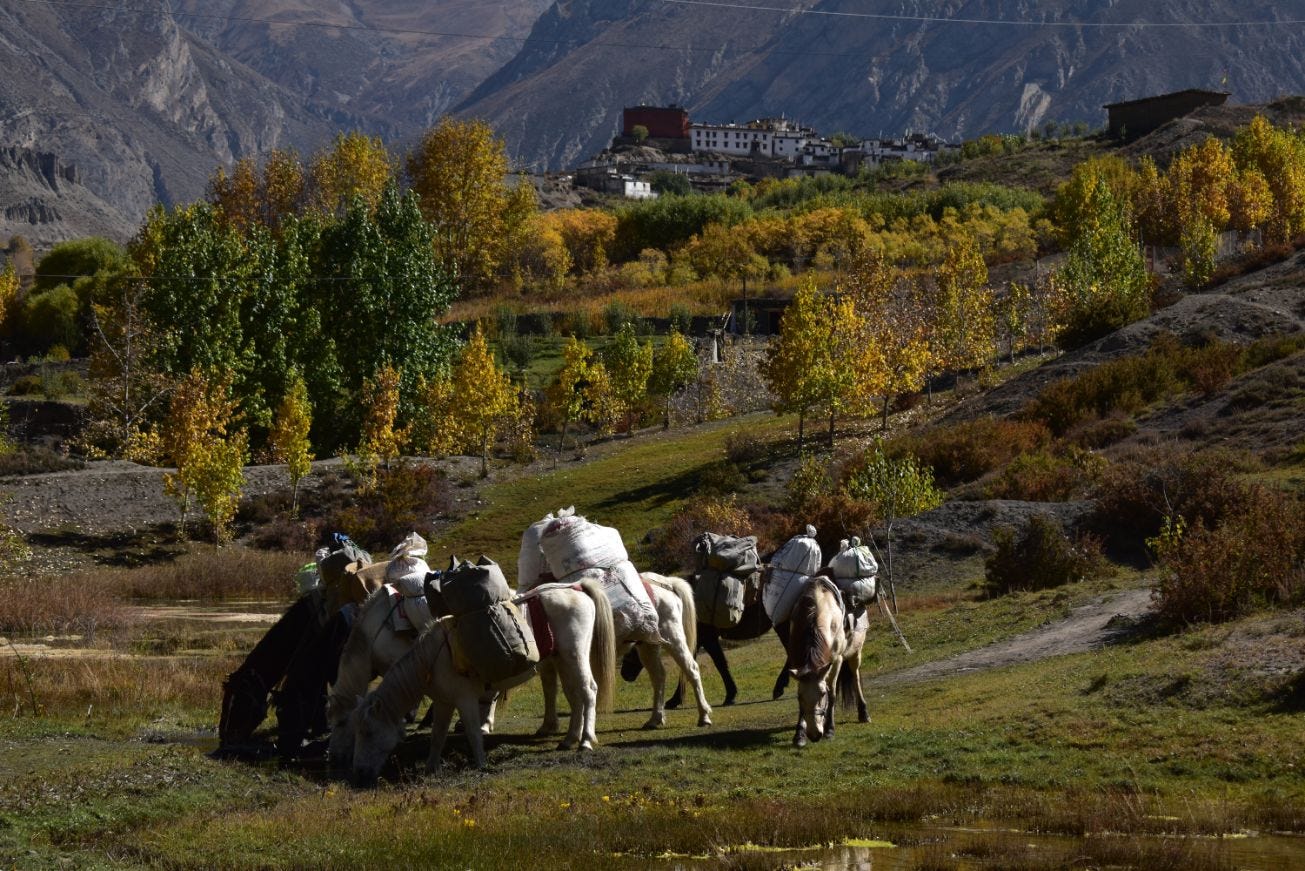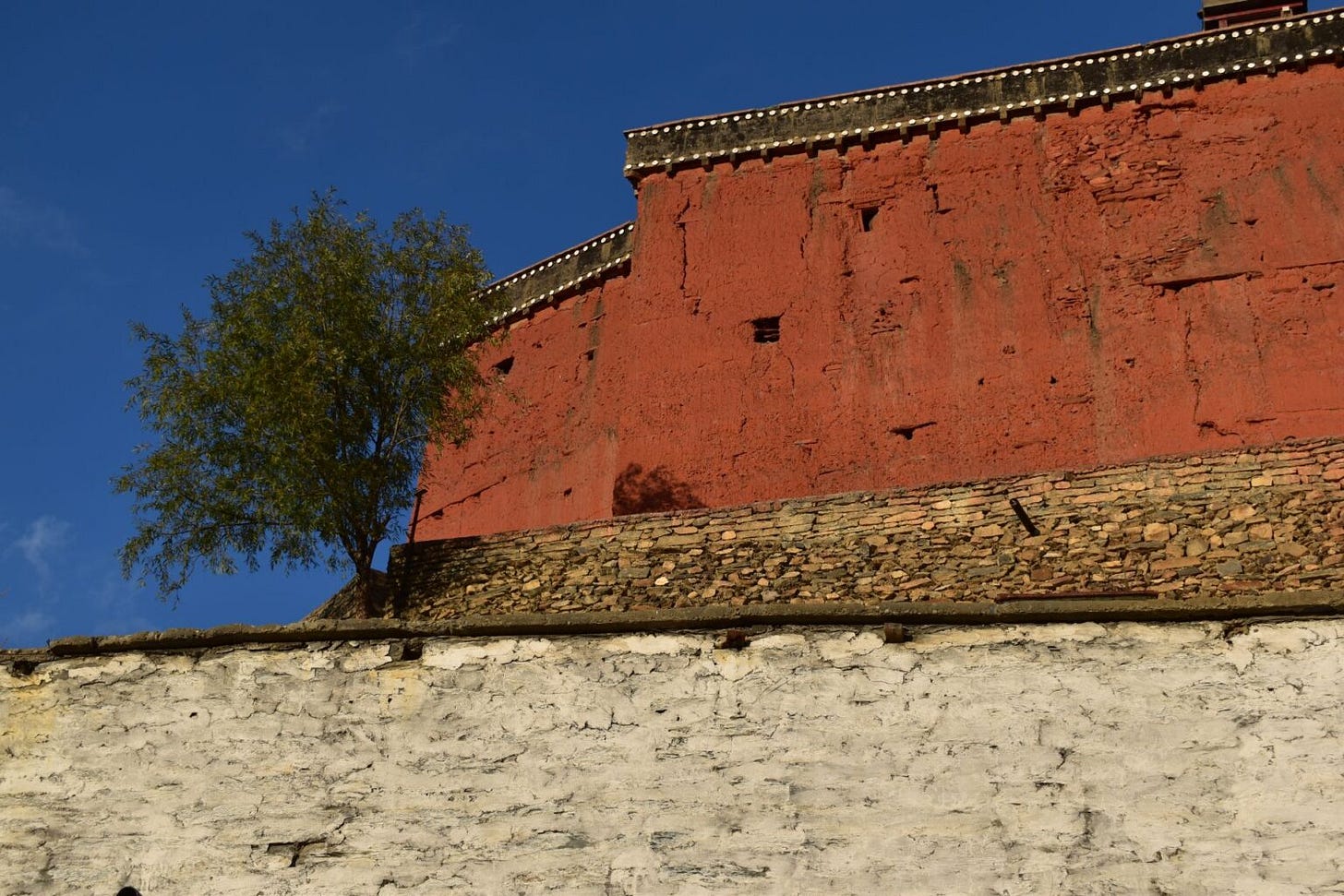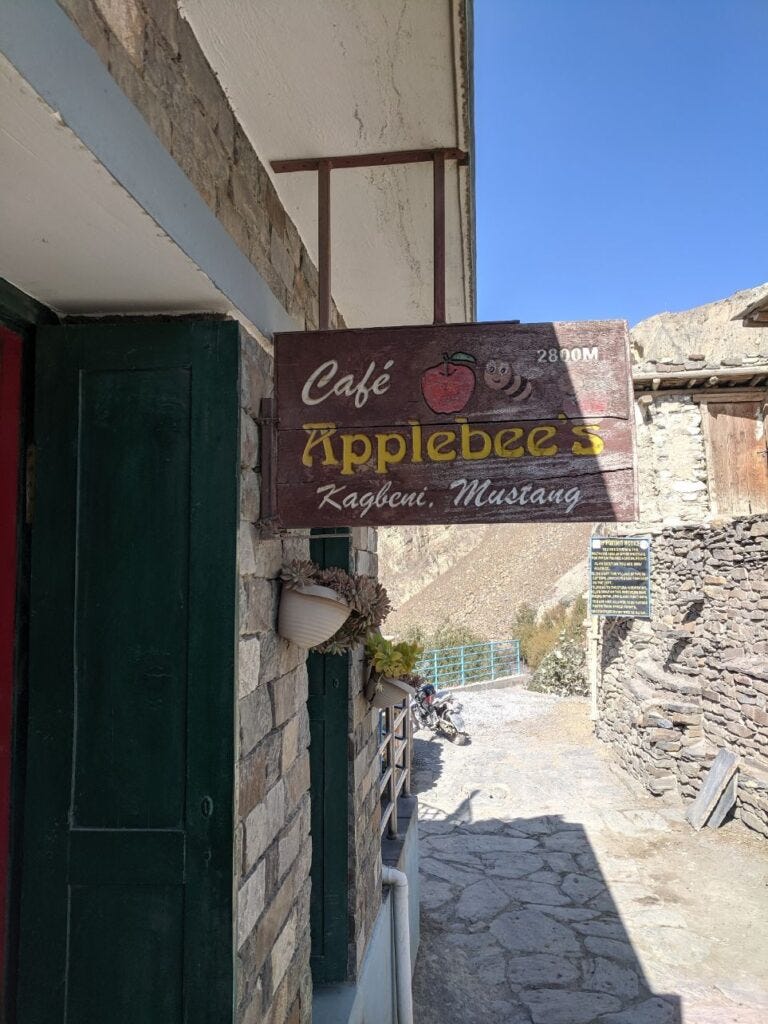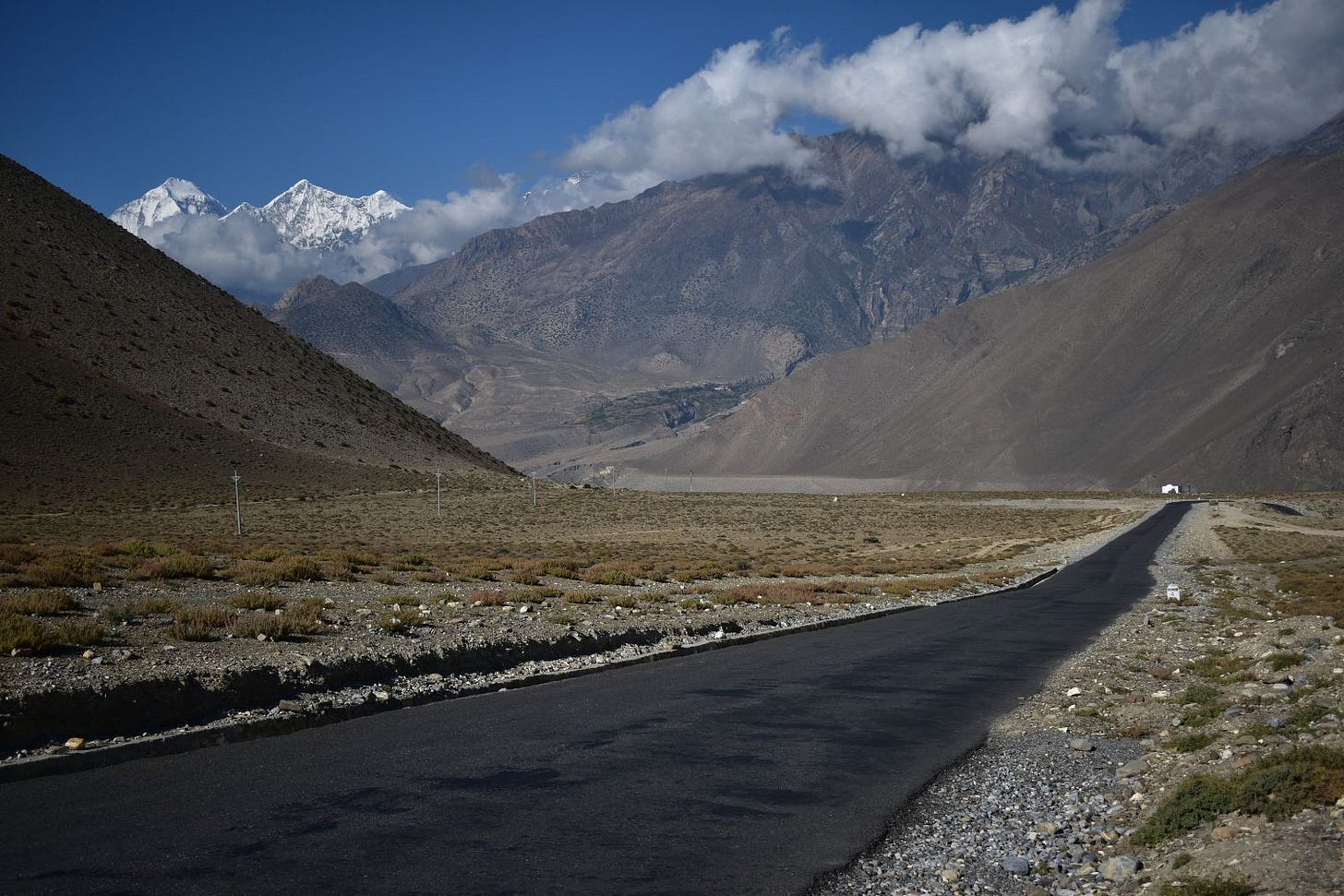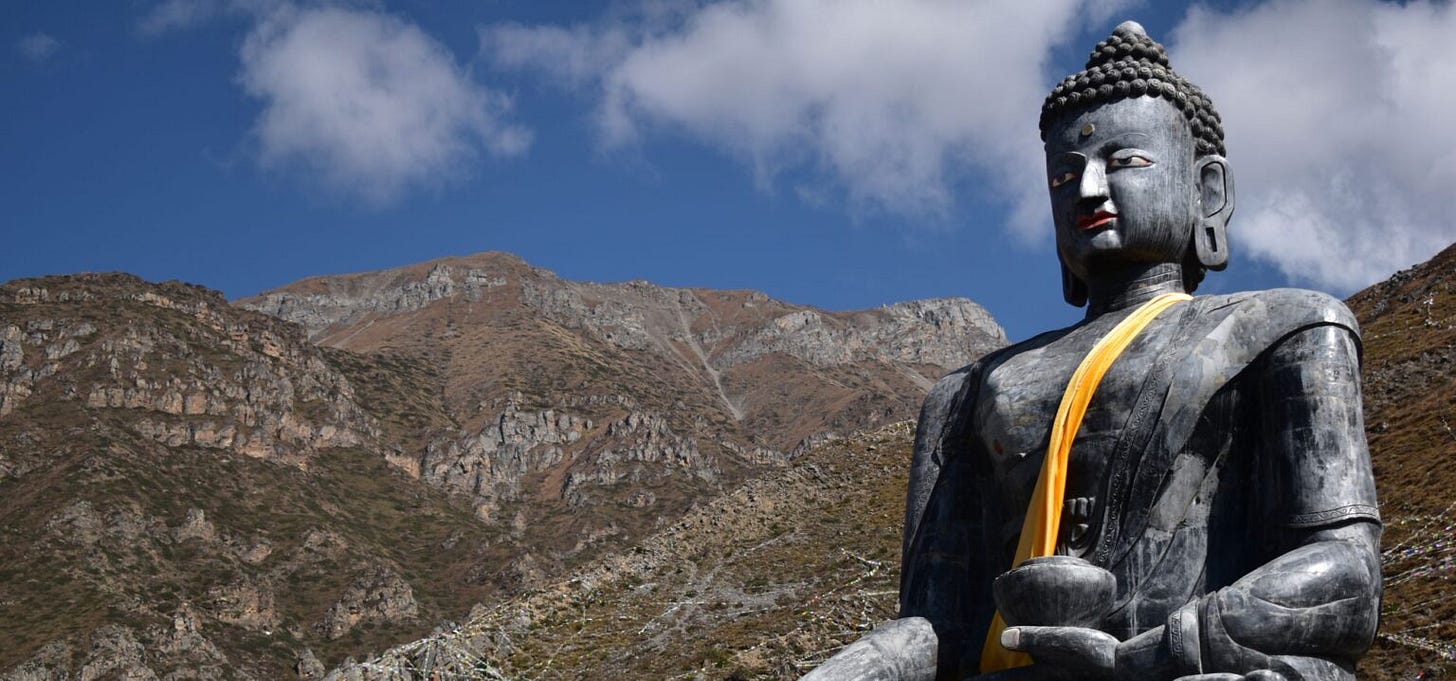The Applebee’s at the End of the Universe
Part III of Home and Away in the Land of Gods and Giants
Local life busied itself as I cruised into the dusty lanes of Kagbeni early in the afternoon. Hawkers stood at their stalls, truck drivers unloaded their goods, young Buddhist monks played football, and orchardists tended to their groves, all giving rhythm to the orchestra of rural Nepali life. There were also more outsiders, Westerners and South Asians alike, about their own business. Groups of high-adventure cyclists flew by with thick-tired bikes as the quickest on-foot trekkers folded up their carbon fiber poles for the day.
Kagbeni is split by a tributary of the Kali Gandaki River and has the air of a well-traveled river town. At the bottom of the riverbed, nakedly standing on a curved rise, Kagbeni is vulnerable to the mercy of the elements. The wind is fierce, preeminent, and consistent, building as the day wears on before it calms in the evening.
The town is only a few hours from Muktinath, the great Vishnu temple hidden behind the Annapurna range in Northern Nepal. Tourists and pilgrims stay a night in the town before venturing to the temple or further into the mountains. I was heading to Muktinath myself and had an evening in Kagbeni to kill.
October marks the beginning of the trekking season and available rooms proved hard to come by. The lodge proprietors are not keen to host solo travelers. Each of the rooms are purposefully outfitted with two single beds, and by renting a room to my lonesome self, they would lose out on half of the chargeable rent.
I bounced from lodge to lodge – avoiding a hotel called ‘Yac Donalds’ – each time growing wearier under the heft of my bag. It was only as the sun began to set behind the mountains that the hostess of the Snow Lion Lodge agreed to take me, knowing few new guests would be arriving after dusk. Selling half a room is better than no room, she must have thought when handing me the key. I took no insult at her obvious reluctance, though. Tourists only stay in Kagbeni for a few months throughout the year, and every night, every bed makes a difference in what she earns. As a meager way of making up the difference, I ordered a more expensive meal that evening – a Tibetan stew with goat meat.
Before eating, I took the afternoon to wander the town’s street. Kagbeni’s narrow alleys, which cut over and below each other like a fortress, were undeniably rough-hewn as I explored them. Stone and clay were fashioned into a patchwork of rustic craftsmanship. Shrines of stacked rock cut the lanes in two, like boulders splitting the current of a heavy-moving stream. I passed a team of men who were stacking stone bricks on a low wall and thought, for such an ancient looking place, Kagbeni felt remarkably under construction. One building stood out among the disarray. The gorgeously painted vermilion brick walls of the local Buddhist temple, Kag Chode, rose above the water and gave center to the maze of alleyways. Kagbeni is a place of religion, first and foremost.
The alleys had the same time-forgotten quality as the rest of Mustang, but there was an unmistakable consumerist bent to the shops and lodges that dotted Kagbeni. Wooden signs for "Full English Breakfast!" and "Cheap Mountain Bike Repair!" cut through the magic of its verisimilitude. Globalism had clearly stretched its gnarly tendrils into that far corner of the world and was now offering me a McDonald’s themed full English at three thousand meters up in the rural Himalaya.
The most curious of all was the Applebee’s. The ‘neighborhood’s favorite bar and grill’ sat at the end of town facing the riverbed north. Without much else to do for the rest of the afternoon, I sought out the wayward Applebee’s, not knowing what to expect.
It was not, of course, an actual Applebee's – one with all-you-can-eat buffalo wings before eight. No, some enterprising local had cribbed the name and logo, knowing full well that curious Americans like myself would come wandering around hoping for the oddest happy hour Coors Light of their lives. Naturally, I walked through the wooden door.
A lonely mid-twenties Nepali sat behind the counter. The cafe was totally empty and, judging by how fast the proprietor bolted upright as the bell rang to announce my entrance, had been for some time. There was a freshness, tidiness to the room that struck me as peculiar. Whereas everywhere else in Mustang was perpetually covered in a layer of silt, the Applebee's was relatively clean, tables wiped. The man stood in front of a name-brand espresso machine flanked by stacks of white porcelain cups. Napkins were neatly folded by the cash register. A selection of pastry dishes decorated the counter window. As a collection of things one would find in a coffee shop, Kagbeni's Applebee's would be fairly conventional, and that disconcerted me. It meant that even the near-medieval stone town I'd just walked through in a windstorm was being Starbucks-ified.
He kindly asked what I would like to drink, and I inquired about the cost of a coffee, wary of the shiny red espresso machine.
"Espresso is 350 rupees, americano 400 rupees."
Roughly three American dollars is exorbitant for coffee in Nepal, so I asked for a Coke instead and stepped outside onto the terrace, uncomfortable with the sterility of the interior.
The view from the terrace, a gash of desolate canyon, tore me away from the creature comforts of the cafe. The country in front of me was Upper Mustang, the mythical heartland of the Kingdom of Lo which begins at the edge of Kagbeni's modest civilization. My travels during the trip were limited to Lower Mustang because visitors to the upper half are highly regulated by the Nepali government and must pay handsomely to gain access.
The awe-inspiring landscapes and other worldliness of my trip were all but a light version of what Mustang had to offer. Upper Mustang is the real deal. There are no amenities, no trekking lodges, no Applebee’s in Upper Mustang.
A sign above the path to my right read:
'IMPORTANT NOTICE – YOU ARE ENTERING THE RESTRICTED AREA OF UPPER MUSTANG FOR WHICH YOU NEED A SPECIAL PERMIT'
'YOU ARE NOT ALLOWED TO GO FURTHER NORTH THAN THESE POINTS.'
There was a forbidden aura to Upper Mustang, as a land left entirely to its own nature. I imagined beyond the confines of the terrace of my faux-Applebee's sprawled a foreign planet, replete with mysterious shamans, impenetrable terrain and alien weather, beasts of prehistoric power, forgotten peoples… It is a place of geology and religion, forces greater than human description.
Truthfully, though, I had no knowledge of what lie beyond that boundary and at the forbidden kingdom's heart. Nor did I really want to know. Mustang was better off without my presence and the creeping wave of commercial travel for which I was a terrible harbinger. There are so few places like it left in the world, and that matters.
I stayed for a while at the Applebee’s staring out in the abyss, then sketched a single haiku in my journal and went to go ask the man for one more thing. He did not, in fact, have any Coors Light.
Mustang is not for man or its simple follies – only gods and giants
A newly paved, tarmac road snakes its way up and out of Kagbeni. At the end of the road lies Muktinath. Muktinath is a sky temple, a sprawling religious complex sitting at over four-thousand meters founded by Tibetan Buddhists and then adopted by Hindus as a shrine to the god Vishnu. The two religions now share the space, though its importance as a Hindu site has overshadowed its original canon. Muktinath is one of only three Divya Desam – the 108 holy temples to Vishnu noted by the poet-saints the Alvars – which reside outside of India. And seeing as how the other two exist outside of the Earthly plane, Muktinath is of great representative value to the Hindu religion (and Hindu interests in Nepal). Pilgrims come from all over South Asia to pay their respects at the sacred flame and take ablutions in the temple's fountains.
The road cutting through Mustang to Muktinath is itself flat, uniform, and wide enough for two buses to pass one another, a complete anomaly by Nepali standards. It was unequivocally the best road I encountered throughout my time in the country, which, given its location, is as remarkable as it is out of place.
The landscape became increasingly fantastical as I followed the strange, paved road. The scenes morphed at each turn of direction. South – the frozen peaks of the Annapurna range. West – the Kali Gandaki riverbed’s sporadic green and orange fields of grass and buckwheat. North – layers of sand-colored cliffs from the planet Arrakis. East – a solitary road switching back and forth to oblivion.
Eventually I left the road, in favor of the trails used by locals to navigate between agricultural settlements. Orchard villages, painted in the distinctive stark white of Tibetan architecture, sprung up the closer I moved to Muktinath. They were fed by creeks of mountain water, creating oases of lush growth which were then colored by the autumnal air. The vibrant yellow-orange foliage and pearl-white buildings were in sharp contrast to the earthen tones which surrounded them. It was as if the villages had insulated themselves from the harshness of Mustang, each their own snow-globe of prosperity and life.
The first thing I saw of Muktinath were the flags. I could not tell what they were initially. There was just a blur of color totally dissimilar to the shades of the villages which interrupted the mountain rock. The closer I moved, though, I realized the entire mountainside above the temple had been covered in a cacophony of prayer flags: red, blue, white, yellow, green repeating ad nauseum. From a religious perspective, the strings were an impressive display of devotion. Aesthetically, the mountainside appeared littered.
The noise of the flags continued down to the temple and then to the town below, Ranipauwa. A circular, dust-covered staging ground had been cleared outside the town’s gates, on which were parked three buses, four jeeps, and a dozen ponies.
There were people, many of them, pouring out of the buses. Predominately older, likely Indian but surely South Asian, they dressed in the equivalent of their Sunday best, bright saris for the women and navy and brown business casual for the men. As they left the buses, they proceeded directly to the group of Nepalis standing in the staging area, each of whom held the reigns of a squat pony. The pilgrims, one at a time and assisted by the wranglers, hopped up onto a pony and proceeded through the town gates at a leisurely walk.
After days of floating alone through Mustang’s gargantuan, empty steppe, I was absolutely floored. There I was, thinking I had been on a journey of solitude in the farthest reaches of the human world to heaven’s own temple, only to be met at its door by a busload of retirees on ponies.
Inside, on the road flowing through Ranipauwa and up to Muktinath, the commotion only grew. Vendors lined the streets selling Tibetan jewelry, trekking supplies, run-of-the-mill Nepali tchotchkes, offerings for the temple, fried foods, and the same billowing “elephant” pants and hemp hoodies found across tourist Asia. Clusters of well-sunned and wild-looking Westerners in neon hiking gear strolled the avenue, pausing at the occasional stall. The same gangs of cyclists I had seen in Kagbeni weaved in and out of the traffic. And all along the road, a cavalcade of ponies shuttled their riders the kilometer and a half to Muktinath.
One slightly overweight woman looked deeply uncomfortable atop her pony. She was dressed in a luminous pink sari and needed to ride side-saddle because of it. I am not sure what precipitated the fall – maybe a hole in the road or a malcontent pony – but the women came crashing down to the floor with a muted shriek. Hands flew to assist her, the wrangler’s, a local vendor’s, a German couple’s, and before I could think to react, she was once again on her steed headed temple-bound, oft to fulfill her sacred pilgrimage.
The rest of my Muktinath visit was fleeting after the shock of the commotion. I know I gave alms at the gate, walked the tree-covered grounds, stared up at the giant statues, and visited the fountains and eternal flame. And then I left. Like so much else in Mustang, I have since decided Muktinath was not meant for me. I was saddened by the commercialization I found at the foot of such a sacred place – I cannot pretend otherwise – but it is not for me to judge who visits that mountain temple, how they arrive there, or what they purchase along the way. Billions of human souls have a greater reverence for the temple and what it represents than I ever could. My role in Mustang was that of a guest, a tourist. Tourism is such a conflicted phenomenon in my heart. It marks the destruction of authenticity, or at least whatever can be construed as authenticity. Foreign travelers have a habit of imposing themselves upon the places they go. As a tourist in Mustang, I was complicit in forcing my need for lodges and English language menus upon the people of the steppe. I brought pollution and capitalism and cultural colonialism with me in my bag. The Applebee's was there for my benefit. I saw the sky-temple on the mountainside covered in prayer flags and thought, "Huh, that looks a little like trash." We're villains, we tourists.
At the same time, though, Mustang is a far more prosperous place than it once was. The busloads of Indian pilgrims and German power-hikers employ thousands of drivers, porters, proprietors, guides, cooks, and orchardists, all of whom can then provide more balanced diets and better educations for their children. Tourism is a tool for growth and exchange, an exploration of ideas and cultures which would never happen otherwise.
I believe in the power of travel. I have to, especially if I want to rationalize my own presence in Mustang. My benefit from the bargain is plain; I get to eat, explore, and learn. I garner stories and photos and crib my own version of Mustang to catalog away for personal fulfillment.
For the people of Mutang – the reticent bus driver who piloted me to Mustang, the porters who joked with me on our way to Muktinath, and the kind hostess who took me in when she did not need to – the deal is less clear. I hope they are able to extract what they can from me and my fellow tourist in order to better fulfill themselves. Perhaps they are also able to take away something from my culture and ideas, and then, the next generation of Nepalis can go travel and exert their own brand of cultural colonialism. That would be karmic justice. The bargain made fair.
When I made my way back to the Kali Gandaki riverbed the next afternoon, I got caught up in one of the afternoon sandstorms that I had been continuously warned about. The dust poured into my hair and eyes, and the wind ate at my lips, and I had no sense of direction besides moving my feet where they’d been pointed. It was terribly uncomfortable and perhaps a little dangerous, but strangely enough, I remember feeling an intense enchantment.
Mustang was deeply alive in that moment, demonstrating its power over everything in the steppe. One day the mountains and wind will reclaim Mustang from our borrowed hands. The Applebee’s, the pony rides, and the paved roads will be forgotten. Muktinath, Kagbeni, and Marpha will be swallowed in the magnanimous erasure of nature. To Mustang, the growing commercialization of its vistas is neither good nor bad. The tourism is only temporary. We are only temporary, a blip in the life of the giant edifices which truly rule the kingdom.


